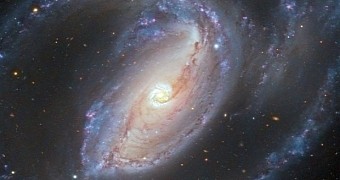There is a reason supermassive black holes are called, well, supermassive. In a new study, a team of astronomers managed to weigh one such chunk of space-time and found it to hold the mass equivalent of 140 million Suns.
Just to put things into perspective, the mass of our parent star is estimated to be one of about 1.989 x 1.030 kilograms. We don't want our brains to implode and so we won't go through the hassle of multiplying this 140 million times. You can give it a go, however, if you're up for the challenge.
This supermassive black hole whose mass astronomers determined with the help of data delivered by the Atacama Large Millimeter/submillimeter Array (ALMA) sits at the center of a galaxy called NGC 1097.
In turn, the barred spiral galaxy, shown in the image next to this article, is located at a distance of about 45 million light-years from our planet, in the direction of the constellation Fornax, researchers explain.
Investigations carried out over the years have shown that every large galaxy hides a supermassive black hole at its core. Even our Milky Way is home to one, albeit it much smaller than the one documented at the center of NGC 1097.
It is believed that galaxies and their center black holes evolve together and influence each other in terms of growth. By weighing black holes and at the same time studying the anatomy of their home galaxies, scientists hope to gain a better understanding of this relationship.

 14 DAY TRIAL //
14 DAY TRIAL //